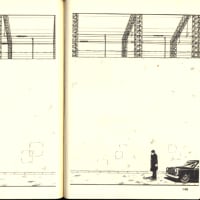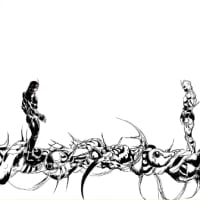まずはこちらから。
<
曽呂利新左衛門 - Wikipedia
https://ja.wikipedia.org/wiki/%E6%9B%BD%E5%91%82%E5%88%A9%E6%96%B0%E5%B7%A6%E8%A1%9B%E9%96%80
秀吉から褒美を下される際、何を希望するか尋ねられた新左衛門は、今日は米1粒、翌日には倍の2粒、その翌日には更に倍の4粒と、日ごとに倍の量の米を100日間もらう事を希望した。米粒なら大した事はないと思った秀吉は簡単に承諾したが、日ごとに倍ずつ増やして行くと100日後には膨大な量になる事に途中で気づき、他の褒美に変えてもらった。(関連: 2の冪 チェス盤と小麦の問題(英語版))
>
と言う有名な逸話だが、どうにも欧米やインドにも似たような話があり、日本のは「洪水伝説」や、あるいは「馬小屋で聖なる人が生まれた伝説」などと同じように、元ネタがある類型のように思われる。
<
2の冪 - Wikipedia
https://ja.wikipedia.org/wiki/2%E3%81%AE%E5%86%AA
古代のインドのセーラムという王の家来、セッサ・イブン・ダヘルがチャトランガ(将棋やチェスの原型となったとされるゲーム)を発明した時、王はこれを喜び、望むだけの褒美を取らせる、と言った。この時の彼の希望は、「盤の最初の升目に一粒の小麦を置き、二升目には二粒、三升目には四粒と増やしていって、最後の升目の分だけを頂きたい」というものであった。この数は、2の63乗であるが、実際の小麦として計算すると、世界の小麦生産高の2500年分を越えるという。
>
<
Wheat and chessboard problem - Wikipedia
https://en.wikipedia.org/wiki/Wheat_and_chessboard_problem
The wheat and chessboard problem (sometimes expressed in terms of rice grains) is a mathematical problem expressed in textual form as:
If a chessboard were to have wheat placed upon each square such that one grain were placed on the first square, two on the second, four on the third, and so on (doubling the number of grains on each subsequent square), how many grains of wheat would be on the chessboard at the finish?
The problem may be solved using simple addition. With 64 squares on a chessboard, if the number of grains doubles on successive squares, then the sum of grains on all 64 squares is: 1 + 2 + 4 + 8 + ... and so forth for the 64 squares. The total number of grains equals 18,446,744,073,709,551,615 (the 64th Mersenne number), much higher than what most intuitively expect.
Macdonnell also investigates the earlier development of the theme.[3]
[According to al-Masudi's early history of India], shatranj, or chess was invented under an Indian king, who expressed his preference for this game over backgammon. [...] The Indians, he adds, also calculated an arithmetical progression with the squares of the chessboard. [...] The early fondness of the Indians for enormous calculations is well known to students of their mathematics, and is exemplified in the writings of the great astronomer Āryabaṭha (born 476 A.D.). [...] An additional argument for the Indian origin of this calculation is supplied by the Arabic name for the square of the chessboard, (بيت, "beit"), 'house'. [...] For this has doubtless a historical connection with its Indian designation koṣṭhāgāra, 'store-house', 'granary' [...].
Carl Sagan titled the second chapter of his final book The Persian Chessboard and wrote that when referring to bacteria, "Exponentials can't go on forever, because they will gobble up everything."[9] Similarly, The Limits to Growth uses the story to present suggested consequences of exponential growth: "Exponential growth never can go on very long in a finite space with finite resources."[10]
>
と言うことで、こちらはインドだけではなくペルシャ(イラン)のチェスボードだともしている。
他にも未来予測本での冪乗数の予測不可能性を挙げるに、上記以外の例として中国まで挙げられている。
未来予測本はどうやらこの寓話が好きなようだ。
2つほど見つけたので、例を挙げてみよう。
マッキンゼーが予測する未来 P012
<
将棋の発明を喜んだ中国皇帝が、その発明者に「褒美を与えるから何でも欲しいものを言ってみよ」と言ったところ、発明者は将棋盤の一つ目の升目に米を1粒、次の升目に2粒、3つめの升目に4粒、四つめの升目には8粒と、数を増やしながら置いていただきたいという望みを伝えた。つまり次の升目に進むごとに倍の数の米粒を所望したのだ。将棋盤を埋める前半戦は、別に波乱のない状況であった。発明者が受け取った米は、一匙の米だったものが、お椀1杯となり、それが大樽1杯となっていった。この物語の別の伝承番のエンディングでは、皇帝は破産し、発明者に取って変わられたということだ。それというのも、倍々の増加を63回繰り返すと、米粒の数は1800京と言う膨大な数(小学校で習う1兆の1800万倍)となり、地球表面積の2倍の広さを敷き詰めることのできる量になるからである。
>
2050年の技術 英『エコノミスト』誌は予測する P81
<
二人が説明に使って言うのは古い寓話だ。チェスを発明した男が、褒美をもらうためチェス盤を国王のもとへ持参する。男は褒美として次のように米粒をもらいたいと持ちかける。チェス盤の一つめのマスには一粒、二つめのマスには二粒、三つめのマスには四粒といった具合に、一マスごとに数を倍増させていくのだ。国王は全体でも大した量にはならないだろうと、すぐに了承した。しかし、チェス盤の後半に入ると一マスで四〇億個と、米粒はとんでもない量になる。しかもマスを追うごとに、米粒の数はそれまでのマスをすべて足し合わせた数よりも大きくなる。
>
<
曽呂利新左衛門 - Wikipedia
https://ja.wikipedia.org/wiki/%E6%9B%BD%E5%91%82%E5%88%A9%E6%96%B0%E5%B7%A6%E8%A1%9B%E9%96%80
秀吉から褒美を下される際、何を希望するか尋ねられた新左衛門は、今日は米1粒、翌日には倍の2粒、その翌日には更に倍の4粒と、日ごとに倍の量の米を100日間もらう事を希望した。米粒なら大した事はないと思った秀吉は簡単に承諾したが、日ごとに倍ずつ増やして行くと100日後には膨大な量になる事に途中で気づき、他の褒美に変えてもらった。(関連: 2の冪 チェス盤と小麦の問題(英語版))
>
と言う有名な逸話だが、どうにも欧米やインドにも似たような話があり、日本のは「洪水伝説」や、あるいは「馬小屋で聖なる人が生まれた伝説」などと同じように、元ネタがある類型のように思われる。
<
2の冪 - Wikipedia
https://ja.wikipedia.org/wiki/2%E3%81%AE%E5%86%AA
古代のインドのセーラムという王の家来、セッサ・イブン・ダヘルがチャトランガ(将棋やチェスの原型となったとされるゲーム)を発明した時、王はこれを喜び、望むだけの褒美を取らせる、と言った。この時の彼の希望は、「盤の最初の升目に一粒の小麦を置き、二升目には二粒、三升目には四粒と増やしていって、最後の升目の分だけを頂きたい」というものであった。この数は、2の63乗であるが、実際の小麦として計算すると、世界の小麦生産高の2500年分を越えるという。
>
<
Wheat and chessboard problem - Wikipedia
https://en.wikipedia.org/wiki/Wheat_and_chessboard_problem
The wheat and chessboard problem (sometimes expressed in terms of rice grains) is a mathematical problem expressed in textual form as:
If a chessboard were to have wheat placed upon each square such that one grain were placed on the first square, two on the second, four on the third, and so on (doubling the number of grains on each subsequent square), how many grains of wheat would be on the chessboard at the finish?
The problem may be solved using simple addition. With 64 squares on a chessboard, if the number of grains doubles on successive squares, then the sum of grains on all 64 squares is: 1 + 2 + 4 + 8 + ... and so forth for the 64 squares. The total number of grains equals 18,446,744,073,709,551,615 (the 64th Mersenne number), much higher than what most intuitively expect.
Macdonnell also investigates the earlier development of the theme.[3]
[According to al-Masudi's early history of India], shatranj, or chess was invented under an Indian king, who expressed his preference for this game over backgammon. [...] The Indians, he adds, also calculated an arithmetical progression with the squares of the chessboard. [...] The early fondness of the Indians for enormous calculations is well known to students of their mathematics, and is exemplified in the writings of the great astronomer Āryabaṭha (born 476 A.D.). [...] An additional argument for the Indian origin of this calculation is supplied by the Arabic name for the square of the chessboard, (بيت, "beit"), 'house'. [...] For this has doubtless a historical connection with its Indian designation koṣṭhāgāra, 'store-house', 'granary' [...].
Carl Sagan titled the second chapter of his final book The Persian Chessboard and wrote that when referring to bacteria, "Exponentials can't go on forever, because they will gobble up everything."[9] Similarly, The Limits to Growth uses the story to present suggested consequences of exponential growth: "Exponential growth never can go on very long in a finite space with finite resources."[10]
>
と言うことで、こちらはインドだけではなくペルシャ(イラン)のチェスボードだともしている。
他にも未来予測本での冪乗数の予測不可能性を挙げるに、上記以外の例として中国まで挙げられている。
未来予測本はどうやらこの寓話が好きなようだ。
2つほど見つけたので、例を挙げてみよう。
マッキンゼーが予測する未来 P012
<
将棋の発明を喜んだ中国皇帝が、その発明者に「褒美を与えるから何でも欲しいものを言ってみよ」と言ったところ、発明者は将棋盤の一つ目の升目に米を1粒、次の升目に2粒、3つめの升目に4粒、四つめの升目には8粒と、数を増やしながら置いていただきたいという望みを伝えた。つまり次の升目に進むごとに倍の数の米粒を所望したのだ。将棋盤を埋める前半戦は、別に波乱のない状況であった。発明者が受け取った米は、一匙の米だったものが、お椀1杯となり、それが大樽1杯となっていった。この物語の別の伝承番のエンディングでは、皇帝は破産し、発明者に取って変わられたということだ。それというのも、倍々の増加を63回繰り返すと、米粒の数は1800京と言う膨大な数(小学校で習う1兆の1800万倍)となり、地球表面積の2倍の広さを敷き詰めることのできる量になるからである。
>
2050年の技術 英『エコノミスト』誌は予測する P81
<
二人が説明に使って言うのは古い寓話だ。チェスを発明した男が、褒美をもらうためチェス盤を国王のもとへ持参する。男は褒美として次のように米粒をもらいたいと持ちかける。チェス盤の一つめのマスには一粒、二つめのマスには二粒、三つめのマスには四粒といった具合に、一マスごとに数を倍増させていくのだ。国王は全体でも大した量にはならないだろうと、すぐに了承した。しかし、チェス盤の後半に入ると一マスで四〇億個と、米粒はとんでもない量になる。しかもマスを追うごとに、米粒の数はそれまでのマスをすべて足し合わせた数よりも大きくなる。
>


























※コメント投稿者のブログIDはブログ作成者のみに通知されます